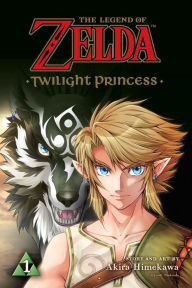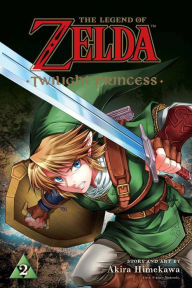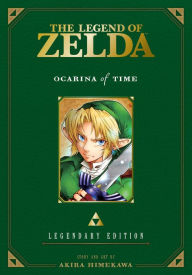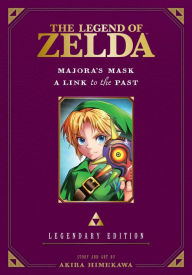A Discussion with the Manga-ka Duo Behind The Legend of Zelda: Twilight Princess
 At this year’s New York Comic Con, I had the privilege of interviewing A. Honda and S. Nagano, the two-woman team who draw the manga adaptation of The Legend of Zelda under the shared pen name of Akira Himekawa. We talked about their work on the original series, now being collected by Viz in two-volume omnibuses as The Legendary Edition, as well as the new series, The Legend of Zelda: Twilight Princess.
At this year’s New York Comic Con, I had the privilege of interviewing A. Honda and S. Nagano, the two-woman team who draw the manga adaptation of The Legend of Zelda under the shared pen name of Akira Himekawa. We talked about their work on the original series, now being collected by Viz in two-volume omnibuses as The Legendary Edition, as well as the new series, The Legend of Zelda: Twilight Princess.
The Legend of Zelda: Twilight Princess, Vol. 1
The Legend of Zelda: Twilight Princess, Vol. 1
In Stock Online
Paperback $11.99
After being away from the Zelda stories for so long, how did it feel to go back and start drawing them again?
S. Nagano: We feel like it’s our duty.
A. Honda: Ten years ago, when the game first came out, we had a lot of people both overseas and in Japan that were saying you have to write a manga about this story because it matches you so well, but the timing was never right. But it felt like our duty; we knew lots of fans were waiting, and that it had to be us to write a manga for this story.
Personally, I knew this would be a really hard one to write and so I felt a lot of pressure approaching this project. We write this for the fans.
What are you doing differently this time? What is the same?
Nagano: One of the biggest differences is there is a lot of darkness in this story that we have to deal with. With our other series, they have mainly been for children’s magazines so there were parts of it that we couldn’t touch that we do here. Because the new series is for an older, more general audience than the previous series, we can incorporate more complexity and darker elements to the theme. One thing that hasn’t changed, though, is that universal story that goes through all of Link’s journeys. We have to make sure we hit all of that in order to keep it all together.
And so up until now, things like death have been taboo because of our audience. Now we are writing to more general, broader audience, kind of like what would be in a movie, and so as a writer it’s not that one is any better than the other, but compared to the previous series, it is more challenging to write Twilight Princess as we do touch upon many more themes in this.
In the past, we have just been very straightforward: the good people are good, the bad people are bad, but here we can touch the more complexities of humans, where good people have weaknesses and flaws.
After being away from the Zelda stories for so long, how did it feel to go back and start drawing them again?
S. Nagano: We feel like it’s our duty.
A. Honda: Ten years ago, when the game first came out, we had a lot of people both overseas and in Japan that were saying you have to write a manga about this story because it matches you so well, but the timing was never right. But it felt like our duty; we knew lots of fans were waiting, and that it had to be us to write a manga for this story.
Personally, I knew this would be a really hard one to write and so I felt a lot of pressure approaching this project. We write this for the fans.
What are you doing differently this time? What is the same?
Nagano: One of the biggest differences is there is a lot of darkness in this story that we have to deal with. With our other series, they have mainly been for children’s magazines so there were parts of it that we couldn’t touch that we do here. Because the new series is for an older, more general audience than the previous series, we can incorporate more complexity and darker elements to the theme. One thing that hasn’t changed, though, is that universal story that goes through all of Link’s journeys. We have to make sure we hit all of that in order to keep it all together.
And so up until now, things like death have been taboo because of our audience. Now we are writing to more general, broader audience, kind of like what would be in a movie, and so as a writer it’s not that one is any better than the other, but compared to the previous series, it is more challenging to write Twilight Princess as we do touch upon many more themes in this.
In the past, we have just been very straightforward: the good people are good, the bad people are bad, but here we can touch the more complexities of humans, where good people have weaknesses and flaws.
The Legend of Zelda: Twilight Princess, Vol. 2
The Legend of Zelda: Twilight Princess, Vol. 2
In Stock Online
Paperback $11.99
Honda: It’s also the fact that these children who used to read our previous series are now adults so they are now reading this.
As creators, you are also more mature.
Nakano: It’s our 30th anniversary now as a duo. And so, if we compare it to ourselves 30 years ago when we first started, I would like to think our drawings have really developed, especially in terms of the details and intricateness.
Even though Link is the main character, each of the stories is different. How do you feel about Link, after writing him for all these years? What traits stay the same, and how have you changed him for the different stories?
Honda: We think of that story and then we think of what kind of a Link that we can create that would really shine within that story. So his personality is always a little different, but in terms of that universal place where he is at between being a child and an adult as a young adolescent boy, we try to find that kind of pureness of adolescence in each Link.
Nagano: This Link in Twilight Princess is a little special. He actually runs from his issues, he runs from his insecurities, and it’s very human in that sense, so we try to draw him as he is.
Is he like a real person to you now?
Honda: Yes, he is. We always approach him as a human, not a character in manga. You see the growth of an individual, a human in his story.
Honda: It’s also the fact that these children who used to read our previous series are now adults so they are now reading this.
As creators, you are also more mature.
Nakano: It’s our 30th anniversary now as a duo. And so, if we compare it to ourselves 30 years ago when we first started, I would like to think our drawings have really developed, especially in terms of the details and intricateness.
Even though Link is the main character, each of the stories is different. How do you feel about Link, after writing him for all these years? What traits stay the same, and how have you changed him for the different stories?
Honda: We think of that story and then we think of what kind of a Link that we can create that would really shine within that story. So his personality is always a little different, but in terms of that universal place where he is at between being a child and an adult as a young adolescent boy, we try to find that kind of pureness of adolescence in each Link.
Nagano: This Link in Twilight Princess is a little special. He actually runs from his issues, he runs from his insecurities, and it’s very human in that sense, so we try to draw him as he is.
Is he like a real person to you now?
Honda: Yes, he is. We always approach him as a human, not a character in manga. You see the growth of an individual, a human in his story.
The Legend of Zelda: Ocarina of Time -Legendary Edition-
The Legend of Zelda: Ocarina of Time -Legendary Edition-
In Stock Online
Paperback $19.99
When we spoke in Canada a few years ago, at TCAF, we discussed your interest in traditional cultures, mythology, and nature. How does that tie in to your most recent Zelda manga?
Honda: We have a lot of nature, lots of spirits, a lot of animals, but it’s also a little different. Although we have these aspects there is also a lot of darkness that takes more of center stage.
Nagano: In the case of Twilight Princess, because of all the darkness that’s in the plot, that’s in this game world, it’s a little hard to incorporate these aspects of nature and animals that we have and that we were talking about last time. So with this series in particular we have really stuck to the game world and that description. It’s been a little hard to include our sense of the natural world.
So, for instance with Ocarina of Time, that world was very spiritual and natural, and it matched up with our image of the natural world, and it was much easier to extend that world in our image of what we wanted it to be. The darkness that Twilight Princess has is not the kind of world that we naturally have, so it’s been a little harder to extend our image of the spiritual and natural world to it in our own style and fashion.
So you think of nature as benign and good, not an evil, scary place?
Nagano: That’s not the case either. We think of nature as something that has both scary elements and very nice and nurturing elements. We definitely recognize both aspects of the natural world, but the natural world is something that was created by the gods. It’s here. This world that’s used in Twilight Princess, that was really created by the game developers. We enjoy depicting the natural world that God created, but in manga we depict the world that the game developer created. So it’s a little different from what we have in the natural world, and it was really hard to change that in our own imagination. The two don’t match.
With the four spirits, and the spiritual world that appears in Twilight Princess, we actually did try to add our own original aspects to this world but in talking to Nintendo, everything didn’t match up, so those ideas weren’t actually used.
When we spoke in Canada a few years ago, at TCAF, we discussed your interest in traditional cultures, mythology, and nature. How does that tie in to your most recent Zelda manga?
Honda: We have a lot of nature, lots of spirits, a lot of animals, but it’s also a little different. Although we have these aspects there is also a lot of darkness that takes more of center stage.
Nagano: In the case of Twilight Princess, because of all the darkness that’s in the plot, that’s in this game world, it’s a little hard to incorporate these aspects of nature and animals that we have and that we were talking about last time. So with this series in particular we have really stuck to the game world and that description. It’s been a little hard to include our sense of the natural world.
So, for instance with Ocarina of Time, that world was very spiritual and natural, and it matched up with our image of the natural world, and it was much easier to extend that world in our image of what we wanted it to be. The darkness that Twilight Princess has is not the kind of world that we naturally have, so it’s been a little harder to extend our image of the spiritual and natural world to it in our own style and fashion.
So you think of nature as benign and good, not an evil, scary place?
Nagano: That’s not the case either. We think of nature as something that has both scary elements and very nice and nurturing elements. We definitely recognize both aspects of the natural world, but the natural world is something that was created by the gods. It’s here. This world that’s used in Twilight Princess, that was really created by the game developers. We enjoy depicting the natural world that God created, but in manga we depict the world that the game developer created. So it’s a little different from what we have in the natural world, and it was really hard to change that in our own imagination. The two don’t match.
With the four spirits, and the spiritual world that appears in Twilight Princess, we actually did try to add our own original aspects to this world but in talking to Nintendo, everything didn’t match up, so those ideas weren’t actually used.
The Legend of Zelda: Majora's Mask / A Link to the Past -Legendary Edition-
The Legend of Zelda: Majora's Mask / A Link to the Past -Legendary Edition-
In Stock Online
Paperback $19.99
I know you have written and drawn other stories besides The Legend of Zelda. With the Zelda books, you are telling stories that many people are already familiar with, from playing the games. What do you do differently when you are telling a story that people don’t already know?
Honda: The huge difference is that when we work on Zelda, there’s a world that Nintendo created, and then we have to rearrange things within that world in order to create our own story, so there’s a level of creativity with the arrangement that we have to do. It has been really hard, in particular with Twilight Princess, because that world was so set already. Whereas working on our own works we get to create that world from scratch, so it’s working with something that inspires us, a piece of inspiration, and then creating world from there.
What inspires your original stories?
Honda and Nagano: Nature.
Do you get out into nature much?
Nagano: Yes, we are always going out to nature. That’s our source of inspiration. Even when we went to Los Angeles in July we went out to Sedona. That’s where we get our energy and that’s where we get our inspiration.
Honda: We also found that when we are doing artwork, our studio has to be near nature. It has to be near that inspiration. We can do work near the city, but in terms of the artwork it has to be near nature.
The Legend of Zelda: Twilight Princess is available now from Viz Media.
I know you have written and drawn other stories besides The Legend of Zelda. With the Zelda books, you are telling stories that many people are already familiar with, from playing the games. What do you do differently when you are telling a story that people don’t already know?
Honda: The huge difference is that when we work on Zelda, there’s a world that Nintendo created, and then we have to rearrange things within that world in order to create our own story, so there’s a level of creativity with the arrangement that we have to do. It has been really hard, in particular with Twilight Princess, because that world was so set already. Whereas working on our own works we get to create that world from scratch, so it’s working with something that inspires us, a piece of inspiration, and then creating world from there.
What inspires your original stories?
Honda and Nagano: Nature.
Do you get out into nature much?
Nagano: Yes, we are always going out to nature. That’s our source of inspiration. Even when we went to Los Angeles in July we went out to Sedona. That’s where we get our energy and that’s where we get our inspiration.
Honda: We also found that when we are doing artwork, our studio has to be near nature. It has to be near that inspiration. We can do work near the city, but in terms of the artwork it has to be near nature.
The Legend of Zelda: Twilight Princess is available now from Viz Media.



